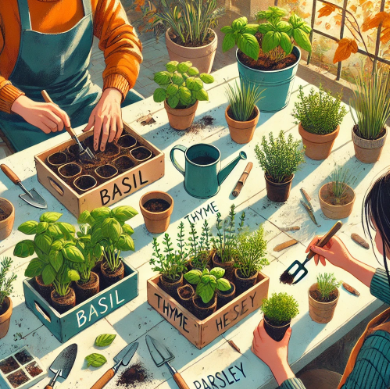Herbal Container Planting for Beginners: Grow Fresh Flavors at Home
Imagine Fresh Herbs at Your Fingertips
Picture this: You’re preparing your favorite meal and step outside to pluck a few sprigs of fresh basil, thyme, or mint from your personal garden. The aroma alone is enough to inspire culinary creativity. If you’ve always wanted to grow your own herbs but thought, I don’t have the space or a green thumb, herbal container planting is your solution. It’s beginner-friendly, requires minimal space, and delivers a rewarding sense of accomplishment.
Why Start Herbal Container Planting?
Container gardening offers a range of benefits for beginners and seasoned gardeners alike:
- Space-Saving: Ideal for balconies, patios, or even windowsills.
- Convenient Access: Fresh herbs are always within reach for cooking and drinks.
- Therapeutic Activity: Gardening is known to reduce stress and improve mood.
- Eco-Friendly: Grow sustainably while reducing your reliance on store-bought produce.
According to a 2023 study, 65% of home gardeners report that growing their own herbs improved their cooking quality and reduced waste—a win-win for your kitchen and the environment.
Essential Tools and Materials for Container Herb Gardening
Before you get started, gather these supplies to ensure a successful herbal container garden:
Checklist of Tools and Supplies:
- Containers: Choose pots with good drainage. Options include terracotta, plastic, and fabric pots.
- Potting Soil: Use high-quality, nutrient-rich soil formulated for container gardening.
- Drainage Material: Add a layer of gravel or broken pottery to prevent waterlogging.
- Gardening Tools: Trowels, pruning shears, and gloves.
Pro Tip:
When selecting containers, ensure they are at least 6-8 inches deep for herbs like basil and parsley, and larger for spreading herbs like mint.
Best Herbs for Beginners
Not all herbs are created equal when it comes to container planting. Here are the easiest and most rewarding options:
| Herb | Light Needs | Watering | Common Uses |
|---|---|---|---|
| Basil | Full Sun | Moderate | Pesto, Salads |
| Mint | Partial Sun | High | Teas, Cocktails |
| Thyme | Full Sun | Low | Soups, Marinades |
| Parsley | Partial Sun | Moderate | Garnishes, Soups |
| Rosemary | Full Sun | Low | Roasts, Aromatics |
Step-by-Step Guide to Planting Herbs in Containers
1. Choosing the Right Container
- Select pots with drainage holes to avoid waterlogged roots.
- For aesthetic appeal, opt for matching containers that complement your space.
2. Preparing the Soil
- Fill pots with potting mix specifically designed for containers.
- Mix in organic compost to enrich the soil with nutrients.
3. Planting the Herbs
- Space herbs properly to ensure adequate airflow.
- Cover the roots gently without compacting the soil too much.
4. Watering and Maintenance
- Water when the top inch of soil feels dry.
- Avoid letting pots sit in standing water to prevent root rot.
Tips for Caring for Your Herbal Container Garden
Watering Guidelines
- Seasonal Adjustments: Increase watering frequency during hot months.
- Drainage Is Key: Herbs hate soggy roots.
Fertilizing
- Feed your herbs every 4-6 weeks with organic liquid fertilizer.
Pest and Disease Control
- Use natural solutions like neem oil for pest control.
- Regularly check leaves for signs of pests or diseases.
Harvesting and Using Fresh Herbs
When to Harvest:
- Begin harvesting when herbs are mature, typically 6-8 weeks after planting.
- Avoid cutting more than one-third of the plant at a time to ensure continuous growth.
Creative Uses:
- Add fresh herbs to pasta, soups, or salads.
- Freeze or dry excess herbs for later use.
Common Mistakes to Avoid in Herbal Container Planting
- Overwatering: Leads to yellowing leaves and root rot. Check soil moisture regularly.
- Neglecting Drainage: Always use pots with drainage holes and add a base layer of gravel.
- Placing in Low Light: Most herbs thrive with at least 6 hours of sunlight daily.
FAQs About Herbal Container Planting
Q1: What are the best herbs for container gardening?
Basil, mint, thyme, parsley, and rosemary are excellent choices for beginners.
Q2: Can I grow herbs indoors?
Yes, as long as they receive adequate sunlight or are placed under grow lights.
Q3: How often should I water my herbs?
Water when the top inch of soil feels dry. Herbs in smaller containers may need more frequent watering.
Q4: What size container is ideal for herbs?
Most herbs require containers that are at least 6-8 inches deep. Larger herbs like mint may need 12-inch pots.
Conclusion: Start Your Herbal Journey Today
Herbal container planting is a simple, rewarding way to bring nature into your home and elevate your cooking. With the right tools, care, and a bit of patience, you can enjoy fresh, flavorful herbs year-round—even in the smallest spaces.
Whether you’re looking to reduce your grocery bill, live more sustainably, or just savor the satisfaction of growing your own food, herbal container gardening is the perfect place to start.

